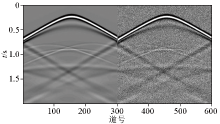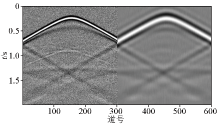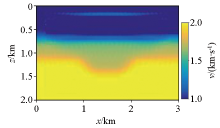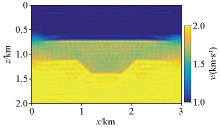|
|
|
| FWI seismic low frequency recovery method based on the U-Net |
WANG Li-Li1,2( ), DU Gong-Xin1, GAO Xin-Cheng3, WANG Ning4, WANG Wei-Hong4 ), DU Gong-Xin1, GAO Xin-Cheng3, WANG Ning4, WANG Wei-Hong4 |
1. School of Computer & Information Technology,Northeast Petroleum University,Daqing 163318,China
2. Heilongjiang Provincial Key Laboratory of Oil and Gas Geophysical Exploration,Daqing 163318,China
3. Modern Education Technology Center, Northeast Petroleum University,Daqing 163318,China
4. School of Earth Science,Northeast Petroleum University,Daqing 163318,China |
|
|
|
|
Abstract The lack of low-frequency data in actual seismic data makes the full waveform inversion (FWI) tend to fall into the local minimum,resulting in poor inversion quality and unreliable results.In view of this,data-driven low-frequency recovery mapping was adopted in this study.First,high-pass and low-pass filters were employed to separate high-frequency and low-frequency data from raw data,respectively,and then data preprocessing was carried out.The processed data were used as the training set of the model.Then,the model was built based on the U-Net to establish the mapping relationship between high and low frequencies.To effectively prevent the model from overfitting,the dropout layer and batch processing layer were added based on the U-Net model.Finally,the trained model was used to predict the corresponding low-frequency data from the high-frequency data and conduct inverse data preprocessing.The errors between the predicted low-frequency data after inverse data preprocessing and the real low-frequency data were compared and analyzed,The effectiveness of multi-scale FWI was verified using the depression and Marmousi models.The experimental results show that the average relative errors between the predicted low-frequency data and the real low-frequency data were 5.02% and 13.32%,respectively for training and test data,indicating small errors and high data coincidence.The inversion results of the depression model,the Marmousi model,and actual data show that the prediction of low-frequency data significantly improved the inversion quality and delivered a great performance in the processing of data with much noise.
|
|
Received: 22 March 2022
Published: 27 April 2023
|
|
|
|
|
|

|
Network structure of improved U-Net model
|

| 名称 | 版本或参数 | | CPU | Intel Xeon Sliver 4210 @2.20GHz 500GB | | GPU | GeForce RTX 2080(16GB) | | CUDA | CUDA 9.0.176 | | CUDNN | CUDNN 7.6.5 | | 操作系统 | Ubuntu 18.04 | | 编译软件 | Pycharm 2019、Matlab R2016a | | 地震处理软件 | Madagascar | | Pyhton解释器 | Python 3.8 | | 深度学习框架 | TensorFlow2.1.0、Keras2.3.1 |
|
Experimental environment
|

| 参数名称 | 参数值 | | 震源数量 | 40 | | 检波点数量 | 120 | | 空间间隔/m | 10 | | 采样间隔/ms | 1 | | 雷克子波/Hz | 15 | | 最大旅行时/ms | 2560 |
|
Finite difference forward modeling parameters
|

|
Spectrum of observation data(part)
|

|
Visual display of training set high-frequency data and corresponding low-frequency tags
a—6 high frequency datas input from 64×64 training sets;b—fig.a low frequency label datas corresponding to high frequency data
|

|
Comparison of real low frequency and predicted low frequency channel set images
a—missing low frequency data;b—predicted low frequency data;c—true low frequency data;d—error between prediction and real low-frequency data
|

|
Spectrum comparison between real low frequency and predicted data
|

|
Comparison of original and supplementary low frequency data gather images
a—original data;b—missing low frequency data;c—predicted low frequency data;d—supplementary data after low frequency prediction
|

|
Spectrum comparison between observed data and supplementary low frequency data
|

|
Waveform comparison of trace 250
|

|
Visual display of test high frequency set and prediction results
a—6 pieces of test high frequency data with the size of 64×64;b—fig. a prediction of low frequency data from test data
|

|
Visual display of feature extraction process of network model
a~e—sampling and feature extraction in the coding process;f~i—upper sampling recovery feature during decoding
|

|
Inversion results of depression model experiment
a—velocity model of depression;b—initial velocity model;c—inversion result of original data;d—inversion result of missing low frequency;e—supplementary prediction low frequency
|

|
Original data of a certain shot of depression model and its predicted low-frequency data gathers
|

|
Inversion results of Marmousi model test
a—velocity model of depression;b—initial velocity model;c—inversion result of original data;d—inversion result of missing low frequency;e—supplementary prediction low frequency
|

|
Original data and predicted low-frequency data athers of a certain shot in Marmousi
|

|
Inversion results of actual data
|

|
Inversion results of actual data with redicted low frequency
|

|
Original data of depression and data trace set after adding noise
|

|
Trace plot of original data of depression with noise and its predicted low-frequency data
|

|
Inversion results of sag original data with noise
|

|
Inversion results of original data of low frequency noise sag supplemented
|
| [1] |
Tarantola A. Linearized inversion of seismic reflection data[J]. Geophysical Prospecting, 1984, 32(6):998-1015.

|
| [2] |
Wu R S, Luo J, Wu B. Seismic envelope inversion and modulation signal model[J]. Geophysics, 2014, 79(3):WA13-WA24.

|
| [3] |
Boßmann F, Ma J. Asymmetric chirplet transform for sparse representation of seismic data[J]. Geophysics, 2015, 80(6):WD89-WD100.

|
| [4] |
Shin C, Cha Y H. Waveform inversion in the Laplace domain[J]. Geophysical Journal International, 2008, 173(3):922-931.

|
| [5] |
Li Y E, Demanet L. Full-waveform inversion with extrapolated low-frequency data[J]. Geophysics, 2016, 81(6):R339-R348.

|
| [6] |
Hu W. FWI without low frequency data-beat tone inversion[C]// SEG Technical Program Expanded Abstracts 2014,Society of Exploration Geophysicists, 2014:1116-1120.
|
| [7] |
刘张聚, 童思友, 方云峰, 等. 基于时域加权的拉普拉斯—频率域弹性波全波形反演[J]. 石油地球物理勘探, 2021, 56(2):302-312.
|
| [7] |
Liu Z J, Tong S Y, Fang Y F, el at. Full waveform inversion of elastic wave in Laplace frequency domain based on time domain weighting[J] Oil Geophysical Prospecting, 2021, 56(2):302-312.
|
| [8] |
Jin Y, Hu W, Wu X, et al. Learn low wavenumber information in FWI via deep inception based convolutional networks[C]// 2018 SEG International Exposition and Annual Meeting,OnePetro, 2018.
|
| [9] |
Sun H, Demanet L. Low frequency extrapolation with deep learning[C]// SEG Technical Program Expanded Abstracts 2018,Society of Exploration Geophysicists, 2018:2011-2015.
|
| [10] |
Ovcharenko O, Kazei V, Kalita M, et al. Deep learning for low-frequency extrapolation from multioffset seismic data[J]. Geophysics, 2019, 84(6):R989-R1001.
|
| [11] |
Ovcharenko O, Kazei V, Peter D, et al. Transfer learning for low frequency extrapolation from shot gathers for FWI applications[C]// 81st EAGE Conference and Exhibition 2019,European Association of Geoscientists & Engineers, 2019(1):1-5.
|
| [12] |
Sun H, Demanet L. Deep learning for low frequency extrapolation of multicomponent data in elastic full waveform inversion[J]. IEEE Transactions on Geoscience and Remote Sensing, 2022, 60:1-11.
|
| [13] |
Fang J, Zhou H, Elita Li Y, et al. Data-driven low-frequency signal recovery using deep-learning predictions in full-waveform inversion[J]. Geophysics, 2020, 85(6):A37-A43.

|
| [14] |
Hu W, Jin Y, Wu X, et al. Progressive transfer learning for low-frequency data prediction in full waveform inversion[J]. Geophysics, 2021, 86(4):1-82.
|
| [15] |
Mousavi A, Baraniuk R G. Learning to invert:Signal recovery via deep convolutional networks[C]// 2017 IEEE International Conference on Acoustics,Speech and Signal Processing (ICASSP),IEEE, 2017:2272-2276.
|
| [16] |
Ronneberger O, Fischer P, Brox T. U-net:Convolutional networks for biomedical image segmentation[C]// International Conference on Medical Image Computing and Computer-Assisted Intervention,Springer,Cham, 2015:234-241.
|
| [17] |
Zeiler M D. Adadelta:an adaptive learning rate method[J]. Computer Science, 2012:1-6.
|
| [18] |
Bunks C, Saleck F M, Zaleski S, et al. Multiscale seismic waveform inversion[J]. Geophysics, 1995, 60(5):1457-1473.

|
|
|
|

